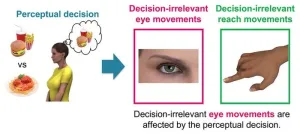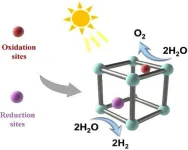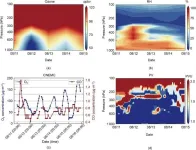(Press-News.org) COLUMBUS, Ohio – As global ice dams begin to weaken due to warming temperatures, a new study suggests that prior attempts to evaluate the mass of the huge floating ice shelves that line the Antarctic ice sheet may have overestimated their thickness.
The research, recently published in the Journal of Glaciology, is the first large-scale study of its kind to compare ice shelf thickness data from ice-penetrating radar measurements to thickness data estimated from contemporary surface elevation measurements.
By juxtaposing vast datasets of 20 of the 300 total separate ice shelf systems that surround about 75% of the Antarctic ice sheet, researchers from The Ohio State University found that on average, the Antarctic ice shelves are nearly 6% thinner than previous studies had assumed, a difference of about 17 meters. This may seem like a small shift in scale, but typical ice shelves can be anywhere from 50 to 600 meters thick.
The study concludes that while prior assumptions about the ice shelves’ thickness were correct on a large scale, their accuracy varied greatly on a small scale, such as for individual structures like valleys or crevasses that are either too narrow or too small to be measured accurately.
Yet as ice shelves play a large role in stabilizing the Antarctic ice sheet as well as Earth’s complex climate system, getting an accurate estimation of their size is essential for calculating how their melt could contribute to sea level rise, said Allison Chartrand, lead author of the study and recent doctoral graduate of the Byrd Polar and Climate Research Center.
“Because the Antarctic ice sheet is so big, a 1% misestimation in how fast it’s melting could mean inches or feet of sea level rise that we’re not accounting for,” she said. “So it’s really important to be as accurate as we can.”
Even the most minute changes to Antarctica’s ice shelves could pose a significant threat to coastal communities, Chartrand said, as a few inches of significantly displaced ice shelf could cause thicker ice to flow into the ocean and potentially cause some coastlines to retreat several feet.
According to Chartrand, she and her co-author, Ian Howat, a glaciologist and a Distinguished University Scholar in earth sciences at Ohio State, first began to investigate ice shelf thickness when examining basal channels – channels in which warmer ocean water melts grooves into the bottom of the ice shelf, accelerating mass loss – during a previous study.
One of the largest discrepancies the study found was that the assumptions used to estimate ice shelf thickness in previous research sometimes exaggerated ice shelf thickness in some areas, and at other times understated it.
While many of these inconsistencies don’t take away much from the big picture, individually, these snapshots are vastly out of focus, said Chartrand. “In comparing the thickness estimate with the radar estimate, we saw that the numbers we had on basal channels and other features like them could be different by up to hundreds of meters, which meant that we could potentially be underestimating or overestimating rates of change,” she said.
Overall, the study concludes that more abundant and accurate data is needed to enable better predictions of ice shelf loss in Antarctica, as the ultimate goal of their work is to improve observations of the processes that contribute to sea level rise, said Chartrand.
“What this research really shows is that we need to be a lot more careful about the assumptions we make to estimate the ice shelf thickness, and about how we account for uncertainties and what they mean for the final result,” she said.
While their work also seeks to inspire others to probe into older datasets, Chartrand hopes that using the past to study the future changes in our environment spurs the development of more advanced technologies, ones that might be able to offer greater aid in the task of assessing the ups and downs of Antarctica’s ever-shifting landscape.
“There’s potential for new discoveries even with data collected anywhere from two to 15 years ago, so we know that a lot still hasn’t been fully explored,” said Chartrand.
This study was supported by NASA and the National Science Foundation.
#
Contact: Allison Chartrand, Allisonchartrand@gmail.com
Written by: Tatyana Woodall, Woodall.52@osu.edu
END
Researchers find Antarctic ice shelves thinner than previously thought
New effort aims to better tally Antarctic ice shelf loss
2023-09-01
ELSE PRESS RELEASES FROM THIS DATE:
Di-isononyl phthalate disrupts pregnancy in mice, study finds
2023-09-01
We are constantly exposed to phthalates in our environment through plastic products such as storage containers, medical devices, packages, fabrics, and toys. Specifically, di-isononyl phthalate is inevitably becoming a part of our lives. Unfortunately, the impact of DiNP on the establishment and maintenance of pregnancy is largely unknown. In a new study, researchers used mice to understand how DiNP affects pregnancy.
“Although we finally recognize that environmental chemicals impact women's health, most studies have focused on men’s reproductive health and very few studies have looked at how these chemicals affect women,” said Jodi Flaws (EIRH co-leader/MME), ...
Health System Program Improved Equity in Allocation of Scarce Medication
2023-09-01
A program designed to ensure fairness and that people living in the most disadvantaged U.S. neighborhoods would be offered a scarce, potentially life-saving medication proved feasible in a large health system. The approach can improve equity in receipt of the drug by people disproportionately affected by disease, according to a new analysis published today in JAMA Health Forum by University of Pittsburgh and UPMC scientist-clinicians.
However, the study revealed that more work needs to be done in building trust with and improving the ability to contact Black patients to ensure they ultimately receive scarce medications and other health care resources ...
Weighted lottery to equitably allocate scarce supply of COVID-19 monoclonal antibody
2023-09-01
About The Study: The results of this study suggest that a weighted lottery to allocate scarce resources is feasible and may result in more drug allocation to individuals who reside in disadvantaged neighborhoods and who identify as Black; however, Black individuals allocated the drug may be less likely to accept allocation and receive it.
Authors: Erin K. McCreary, Pharm.D., of the University of Pittsburgh School of Medicine, is the corresponding author.
To access the embargoed study: Visit ...
Telehealth vs in-clinic medication abortion services
2023-09-01
About The Study: The findings of this study suggest that telehealth medication abortion services (tele-MAB) facilitates abortion care access for those further from brick-and mortar abortion facilities and, thus, may mitigate the impacts of travel logistics and costs. Additionally, tele-MAB may better meet the needs of those with prior abortion experience, perhaps due to greater familiarity with the abortion process.
Authors: Anna E. Fiastro, M.P.H., M.E.M., Ph.D., of the University of Washington in Seattle, is the corresponding author.
To access the embargoed study: Visit our For The Media website at this link https://media.jamanetwork.com/
(doi:10.1001/jamanetworkopen.2023.31900)
Editor’s ...
The eyes are a window into the deciding mind
2023-09-01
Researchers worldwide are seeking visible indicators of what is going on inside our minds as we think about issues and take decisions. They are searching for the ability to probe the invisible workings of the mind by monitoring subtle signals from the body. New insights from experiments at Tohoku University have revealed a link between eye movements and certain types of decision-making. Kazumichi Matsumiya and Shota Furukawa at the university's Graduate School of Information Sciences reported their findings in the journal Communications Biology.
"Our work has revealed that eye movements that are not ...
Three types of boreal summer intraseasonal oscillation influence precipitation over the Yangtze river valley in various ways
2023-09-01
The Yangtze River Valley (YRV) is one of the most densely populated and economically developed regions in China. Summer precipitation over this region shows considerable intraseasonal variability with a period of 10–90 days, which can induce extreme precipitation events and lead to massive economic losses and human casualties.
The Boreal Summer Intraseasonal Oscillation (BSISO) is the intraseasonal variability active in the tropical Indian Ocean and western Pacific region. Over the last three decades, scientists have studied the influence of the BSISO, because it is an essential predictability source in extended-range forecasts.
A new study published in Atmospheric ...
Roadmap drafted for research into metallic ‘sponges’ for clean hydrogen
2023-09-01
Metal organic frameworks (MOFs) could deliver a major efficiency boost to the photocatalytic production of clean hydrogen. Chemical engineers have drafted a comprehensive overview of the state of their field and a plan for where it needs to focus.
Clean hydrogen production remains an energy-intensive and therefore costly proposition, inhibiting the battle against global warming. Metal organic frameworks—in effect tiny molecular ‘sponges’—look set to radically improve the efficiency of photocatalytic production of hydrogen due to their unique structural ...
Radical new approach to managing type 2 diabetes receives $3.5 million from NIH
2023-09-01
The National Institutes of Health has provided $3.5 million for a large-scale clinical trial testing a radical new approach to managing type 2 diabetes that, in an earlier study, put almost 70% of participants in remission without weight loss or medication.
The approach was developed by UVA Health’s Daniel J. Cox, PhD. It is built on the notion that educating people about how to make wise dietary and exercise choices can allow them to control their blood sugar and possibly even alter the course of the disease.
“Instead of focusing on reducing weight with diets ...
Breakthrough in atmospheric analysis: Chinese satellite delivers high spatial resolution ozone profiles
2023-09-01
A breakthrough in satellite observations has allowed scientists to obtain high spatial resolution ozone profiles, enhancing our understanding of ozone distribution and its impact on the atmosphere. The research, conducted by the research team led by Cheng Liu and Fei Zhao at the University of Science and Technology of China, utilized data from the Environmental Trace Gases Monitoring Instrument (EMI) on the Gaofen-5 satellite, the first Chinese ultraviolet-visible hyperspectral spectrometer.
Ozone plays a crucial role in the atmosphere, and understanding its vertical distribution is key to comprehending its horizontal and vertical transport, as well as its physical and chemical ...
Flowering for naught: 120 years with nothing to show
2023-09-01
A long-lived monocarpic species of bamboo, Phyllostachys nigra var. henonis, only flowers once every 120 years before it dies. The upcoming flowering event for this species does not bode well for its continued long-term survival, as most flowers are not producing viable seeds.
Flowering for some plants is a yearly occurrence, for others, it is a once-in-a-lifetime event. A widespread species of bamboo in Japan, Phyllostachys nigra var. henonis, takes this one-time flowering event and pushes it to the extreme: they flower once every 120 years before dying to make way for the next ...
LAST 30 PRESS RELEASES:
University of Oklahoma researcher awarded funding to pursue AI-powered material design
Exploring how the visual system recovers following injury
Support for parents with infants at pediatric check-ups leads to better reading and math skills in elementary school
Kids’ behavioral health is a growing share of family health costs
Day & night: Cancer disrupts the brain’s natural rhythm
COVID-19 vaccination significantly reduces risk to pregnant women and baby
The role of vaccination in maternal and perinatal outcomes associated with COVID-19 in pregnancy
Mayo Clinic smartwatch system helps parents shorten and defuse children's severe tantrums early
Behavioral health spending spikes to 40% of all children’s health expenditures, nearly doubling in a decade
Digital cognitive behavioral treatment for generalized anxiety disorder
Expenditures for pediatric behavioral health care over time and estimated family financial burden
Air conditioning in nursing homes and mortality during extreme heat
The Alps to lose a record number of glaciers in the next decade
What makes a good proton conductor?
New science reporting guide published for journalists in Bulgaria
New international study reveals major survival gaps among children with cancer
New science reporting guide published for journalists in Turkey
Scientists develop a smarter mRNA therapy that knows which cells to target
Neuroanatomy-informed brain–machine hybrid intelligence for robust acoustic target detection
Eight SwRI hydrogen projects funded by ENERGYWERX
The Lundquist Institute and its start-up company Vitalex Biosciences Announces Strategic Advancement of Second-Generation fungal Vaccine VXV-01 through Phase 1 Trials under $40 Million Competitive Con
Fine particles in pollution are associated with early signs of autoimmune disease
Review article | Towards a Global Ground-Based Earth Observatory (GGBEO): Leveraging existing systems and networks
Penn and UMich create world’s smallest programmable, autonomous robots
Cleveland researchers launch first major study to address ‘hidden performance killer’ in athletes
To connect across politics, try saying what you oppose
Modulating key interaction prevents virus from entering cells
Project explores barriers to NHS career progression facing international medical graduates
Jeonbuk National University researchers explore the impact of different seasonings on the flavor perception of Doenjang soup
Two Keck Medicine of USC Hospitals named Leapfrog Top Teaching Hospitals
[Press-News.org] Researchers find Antarctic ice shelves thinner than previously thoughtNew effort aims to better tally Antarctic ice shelf loss







